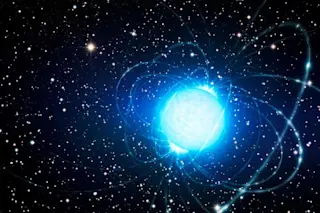Roughly 11.5 million years ago in a galaxy not too far away, a starquake cracked the surface of a small and violent stellar corpse. This rupture caused an enormous flare that sent X-rays and gamma rays racing across the universe. After traveling for millions of years, the flood of high-energy radiation finally washed over our inner solar system just before 5 A.M. EST on April 15, 2020, lighting up the sensors of spacecraft orbiting the Sun, Earth, and Mars. The signal lasted just a fraction of a second, but it still offered telltale clues about where it came from.
And last week, a team of scientists studying the event announced they've deduced the bizarre origins of this cosmic flood of radiation. The signal came from a strange star called a magnetar — short for magnetic star — an extreme object that packs the mass of our Sun into a city-sized ...














